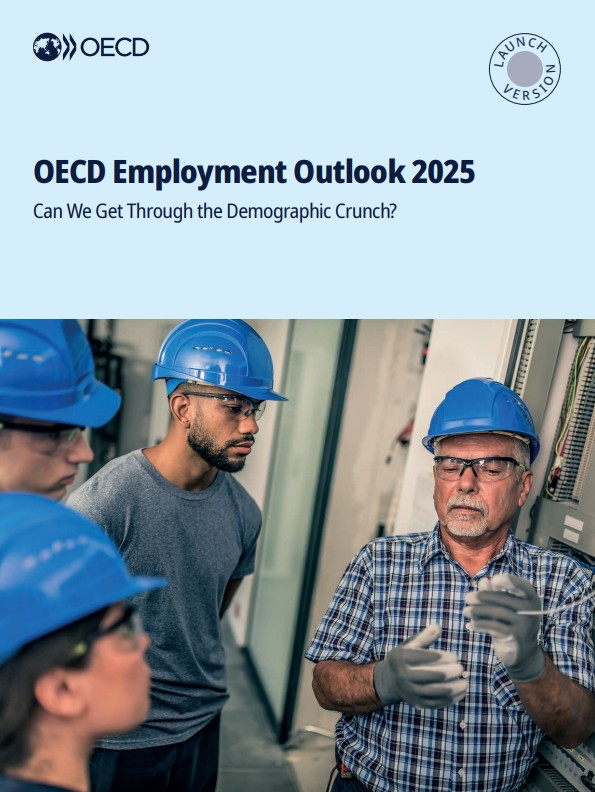
□ 보고서에 따르면 OECD의 실업률은 2025년 5월 기준 4.9%로, 1년 전과 동일한 수준을 유지함. 그러나 많은 국가에서 고용 성장의 둔화와 코로나19 이전 수준의 노동시장 경색 조짐이 나타남
ㅇ 한국의 실업률은 2025년 5월 기준 2.7%를 나타내고 있으며, 2024년 5월 기준 2.8%, 2023년 5월 기준 2.5%로 나타나 팬데믹 이후 기간 동안 3%이하의 실업률을 유지하고 있음. 한국의 고용률은 2023년 1분기 68.8%, 2024년 1분기 69.5%, 2025년 1분기 69.7%로 지속적으로 증가세를 보임. 같은 기간 동안 남성의 고용률은 여성의 고용률보다 10%포인트 이상 높은 수준임. 고용률은 팬데믹 이후 지속적으로 증가하고 있지만, OECD 평균에는 하회한 상태임
□ 실질임금은 거의 모든 OECD 회원국에서 증가하고 있지만, 그 중 절반에서는 팬데믹 이후 이어진 인플레이션 급등 직전인 2021년 초 수준의 임금을 여전히 밑돌고 있음
ㅇ 한국의 실질임금은 지난 몇 년간 지속적으로 상승세를 이어오고 있으며, 특히 2021년 1분기 이후 누적 기준으로 2.9%를 초과하는 강한 증가세를 기록하며 OECD 중위값을 상회함. 법정 최저임금은 지속적으로 인상되어 왔으며, 2025년의 명목 최저임금은 2021년 대비 15% 증가함. 그러나 2021년 1분기 이후의 고물가 영향으로 실질 최저임금의 증가율은 0.8%에 그치고 있음
□ OECD 국가에서는 2060년까지 노동 연령 인구 1인당 노인 인구의 수가 67% 증가할 것으로 예측됨. 정책 변화가 없을 경우, 고용률은 감소하고 연간 1인당 GDP 성장률이 0.4 %포인트 둔화될 것으로 예상됨
ㅇ 한국의 노동 연령 인구는 팬데믹 이후 지속적으로 감소함. 15세부터 64세까지의 인구는 2020년 3,664만 명에서 2024년에는 3,562만 명으로 감소함. 특히, 한국은 2022년에 0.78%, 2023년에는 0.72%의 출생률을 보이고 있어, OECD 국가 중 가장 낮은 출생률을 기록함. 이 인구 구조적 변화는 노동시장에 커다란 영향을 미치고 있음. 한국의 고용률은 2023년부터 2060년까지 8.1% 감소할 것으로 예측됨. 이 수치는 OECD 평균인 1.9% 감소를 크게 상회하는 수준임
ㅇ 한국 정부는 평생 학습 강화, 정년 연장 촉진, 고령자 재고용 지원, 육아 휴직 확대 및 출산휴가 강화 등 다양한 정책을 통해 노동 수명 연장 등을 추진함으로써 노동시장의 인구 구조의 변화, 특히 고령화와 노동력 인구 감소에 적극적으로 대응하고 있음
[출처] OECD 2025 고용전망: 대한민국 (2025.07.09.) / OECD
목차
Foreword 3
Editorial: From job shortage to labour shortage: The new challenge of population ageing 4
Executive summary 13
1 Bouncing back, but on shaky ground: Wages continue to recover in uncertain labour markets 16
In Brief 17
Introduction 18
1.1. Labour markets have been supported by resilient economic growth but there are early signs of slowdown 18
1.2. Labour shortages continued to ease but labour markets remain tight 25
1.3. Real wages are growing in virtually all OECD countries but there is still room for catching up in many of them 34
1.4. Concluding remarks 46
References 47
Annex 1.A. Additional results 50
Notes 65
2 Setting the scene: Demographic change, economic growth and intergenerational inequalities 67
In Brief 68
Introduction 70
2.1. Population ageing: Past and future trends 71
2.2. Population ageing and economic growth 75
2.3. Potential gains from mobilising untapped labour resources 78
2.4. Inequalities in living standards across generations 93
2.5. Concluding remarks 103
References 104
Annex 2.A. Additional Figures 116
Notes 126
3 Navigating the golden years: Making the labour market work for older workers 132
In Brief 133
Introduction 134
3.1. Evolving employment trends among mid-to-late career workers 135
3.2. Strengthening incentives for longer working lives 152
3.3. Boosting the hiring and retention of older workers 161
3.4. Promoting the employability of workers throughout their working lives 169
3.5. Concluding remarks 176
References 177
Annex 3.A. Additional charts 188
Notes 200
4 Staying in the game: Skills and jobs of older workers in a changing labour market 204
In Brief 205
Introduction 207
4.1. Generational divide or age-related decline: How will productivity evolve with age in the future? 207
4.2. Lifelong learning: The key to ageing well – but are workers using it? 218
4.3. Policy solutions: Support mid-career and older workers now to age better tomorrow 225
4.4. Concluding remarks 231
References 232
Annex 4.A. Additional results 238
Notes 244
5 Reviving growth in a time of workforce ageing: The role of job mobility 246
In Brief 247
Introduction 249
5.1. Setting the scene 252
5.2. Growth, reallocation and ageing 257
5.3. Policy implications 271
5.4. Concluding remarks 280
References 282
Annex 5.A. Supplementary material 289
Notes 297
Annex A. Statistical annex 300


